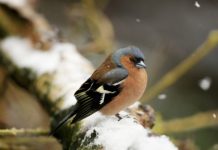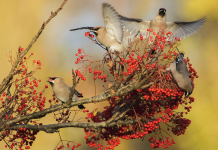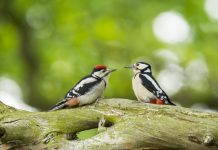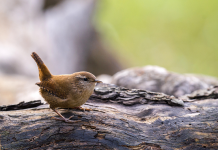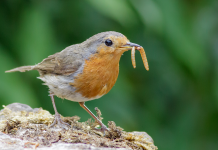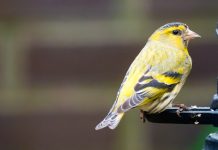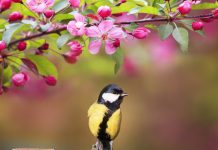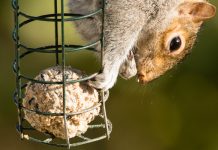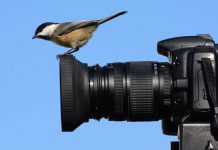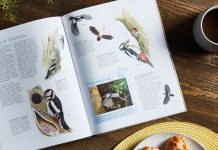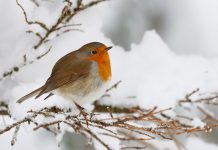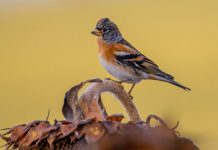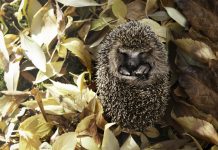Autumn is a second spring when every leaf is a flower.
– Albert Camus
The season of mists and mellow fruitfulness is well underway, and with it we have waved a fond farewell to our feathered summer visitors, meanwhile welcoming in our winter migrants. Many birds start to arrive in the UK during autumn in search of more accessible food throughout the winter, and to take advantage of the milder weather than in their native countries. There is plenty that we can do in our gardens in autumn to help our feathered friends and other forms of wildlife.
Delve into this month’s Your Happy Beaks Garden to discover birds to spot this month, what will help your garden thrive this October, and how to enter our #SnappyBeaks competition!
Garden Birds to Spot in October
Yellowhammer
With its bright yellow head and underparts, the yellowhammer – particularly the male – is an unmistakable and striking bird. Making their home in open countryside such as farmland, grassland and heathland, they are often seen perched atop hedges or bushes, or flying overhead in large flocks. October is a particularly good time of year for spotting yellowhammers, as migrating individuals begin arriving from Continental Europe and Scandinavia this month to take advantage of our milder winters.
Feeding on seeds and insects, this colourful bunting is known for its high-pitched song of ‘a little bit of bread and no cheeeese’, often delivered from a vantage point at the top of a bush. If you can coax them into the garden, they will happily take seed mixes from the ground or bird table.
Did you know?
- Yellowhammers gather in small flocks outside of the breeding season, making autumn and winter a great time of year for spotting them.
- Yellowhammers nest on the ground or low down in dense vegetation. The female builds the nest and incubates the eggs, whilst the male brings her food. The eggs are camouflaged to blend in with the surroundings.
Pheasant
Magnificently colourful plumage and impressively long, pointed tail feathers make male ring-necked pheasants unmistakable. Speckled chestnut and cream feathers contrast with the male’s iridescent blue-green neck, white collar and bright red patch around the eye. The female’s plumage is much more low-key, being a speckled light brown all over, whilst the young chicks are adorably stripey.
First introduced to Britain by the Romans, pheasants nest on the ground and spend almost all of their time on the ground. They are notoriously reluctant to take to the wing, preferring to run to get out of danger, and are virtually never seen in trees. Mature cock pheasants occupy prime territories along the edge of woodlands, whilst younger males must live further out into the open, using hedgerows or copses for cover. At this time of year, pheasants may form small flocks in which they will overwinter. Whilst on the ground, pheasants forage for a wide variety of foods, including seeds, grain, berries and insects. They will frequently venture into gardens and can often be seen feeding on fallen seeds below the bird table.
Did you know?
- A successful male pheasant may have a harem of up to a dozen females during the breeding season, but is relieved of all responsibility after mating.
- When chased, a pheasant can fly for short bursts at speeds of up to 60mph!
Gardening in October
Veg Gardens
- Finish harvesting apples and pears, and store surplus apples in a cool, dry place where many varieties will keep well into winter.
- Remove tomato plants from greenhouses before they start to become mouldy. Not-quite-ripe tomatoes can be ripened on a windowsill indoors, whilst green fruits can be made into delicious chutney.
- Divide mature rhubarb crowns to create new plants. This should be done every five years or so to renew vigour.
- Plant out spring cabbages to enjoy an early crop come spring.
Flowers & Bulbs
- Cut back herbaceous perennials that have died down, lifting and dividing where needed to reduce congestion in your borders and give each plant space to grow into next season.
- Plant spring bulbs in pots and borders for a colourful springtime display to look forward to over winter. You can achieve a stunning effect by planting different bulbs in layers in a pot, known as a ‘bulb lasagne’.
- Bring tender plants into a greenhouse or conservatory before the first frosts arrive.
- Take advantage of the cooler, wetter conditions to repair or renovate lawns by laying new turf.
Wildlife Gardening
- If you need to have a bonfire this autumn, always check the pile beforehand for hibernating hedgehogs and toads.
- Top up bird feeders, not forgetting our ground-feeding visitors. With the breeding season finished, all types of feed – including peanuts – are now safe to use.
- Leave some flower seedheads intact when you’re cutting back, as these will attract finches.
- You can also put bundles of twigs at the back of borders or in wildlife areas to provide overwintering habitat for a range of wildlife.
- Autumn is the time to clear out your pond, removing any debris, detritus and excess plant growth that may have taken over. Pond plants should only cover around one third of the pond surface. Leave all removed material by the side of the pond for two days to allow any aquatic creatures to find their way back into the pond.
#SnappyBeaks
Thank you to everyone who entered our #SnappyBeaks competition last month. We love seeing your entries! Each month we showcase some of your best birdy snaps, in the garden and in the wild, and give you a chance to win a prize in the process.
It’s so simple to enter! Just share your photo with us on any of our social media platforms, using the hashtag #SnappyBeaks. You can enter via Instagram, Facebook, Messenger or Twitter. As long as your photo is related to wild birds or bird feeding in some way, we’ll consider it as a valid entry. Find out more on our Snap Of The Month competition page.
Helping wildlife this autumn
There are some easy but really important jobs you can do in your garden this autumn to help wildlife. Now that breeding season is over, but the really cold nights haven’t yet set in, this is the perfect time to clear out nest boxes before the next residents take up occupancy to prevent spread of disease, and to put new ones up to give birds plenty of time to find them before the nesting season. You could even install a hedgehog house to give these adorable prickly customers somewhere cosy to hibernate over winter.
For more information on easy ways you can help wildlife in your garden this month, see our guide to helping wildlife in autumn.

